An oral history of the iconic 1987 Justice League
Revisiting the 'Bwah-ha-ha' era of the Justice League with Giffen, DeMatteis, and Levitz
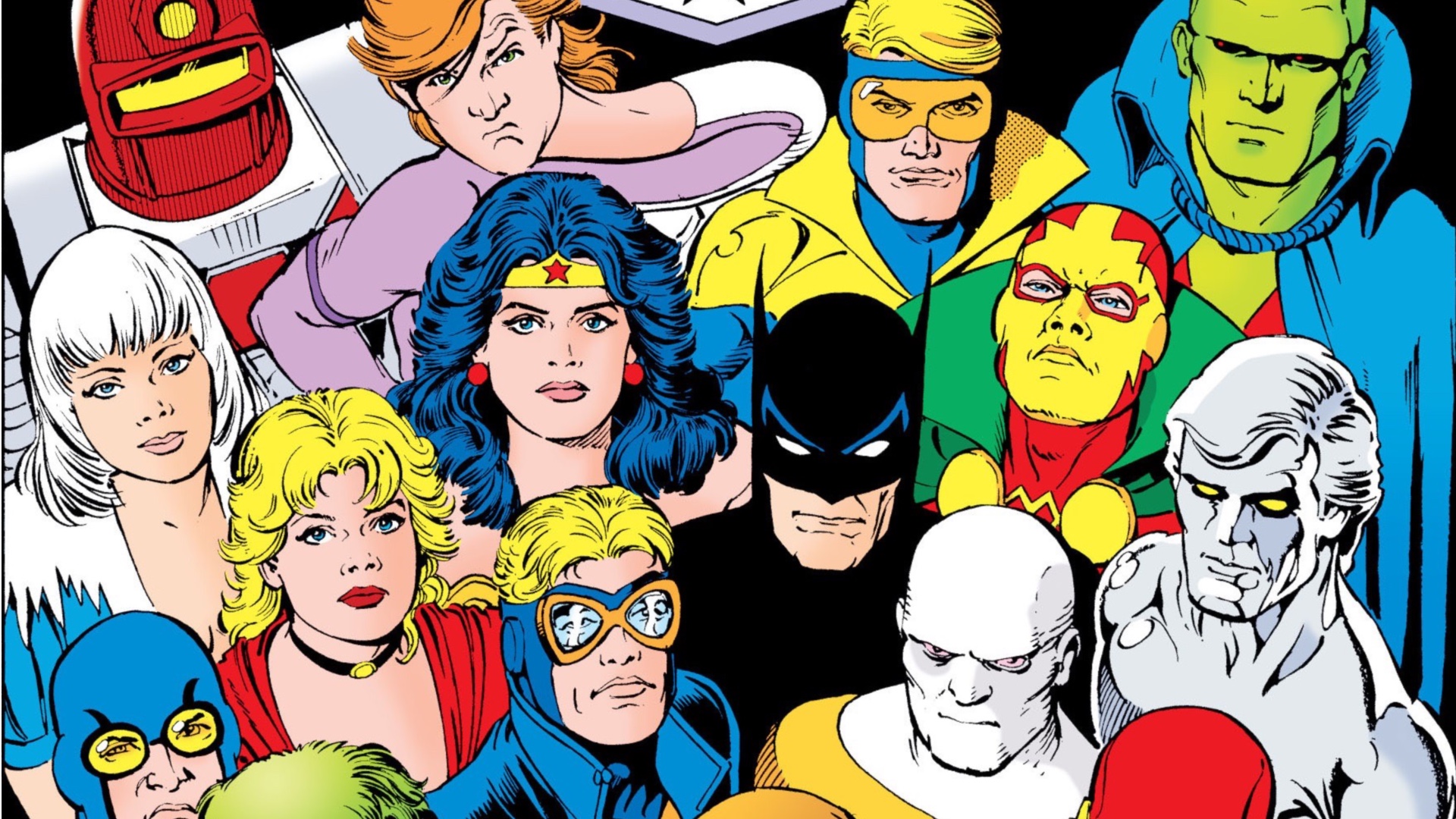
It started with a "bwah-ha-ha," and it looks like it will never end.
It was an upset-the-apple-cart time at DC back in 1987. The company was making tsunami-sized waves with Watchmen and The Dark Knight Returns. Within the DC Universe proper, Superman was getting a massive reboot courtesy of John Byrne and The Man of Steel, and the company was also in the midst of an all-hands-on-deck crossover called Legends.
Into this time was born a new Justice League. The immediate prior incarnation was forgettable. Now, as the wheel is about to turn again with a Justice League relaunch apparently coming sometime later in 2023, we're looking back at the history of one of the most successful Justice League relaunches ever, which defined the team for years to come.
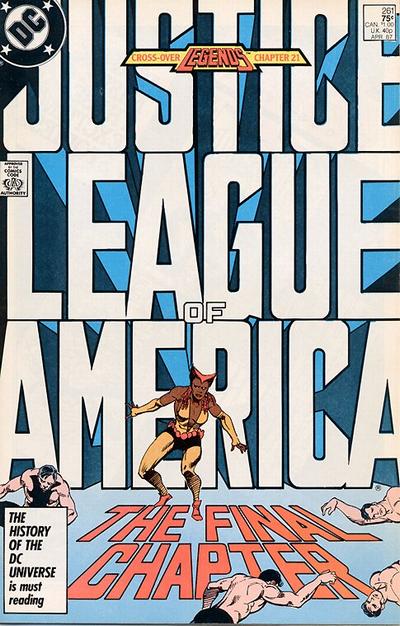
Justice League America started back in the early '60s as a showcase for DC's top heroes—Superman, Batman, Wonder Woman, Flash, Green Lantern, and the like. But by 1984, DC shifted the team to Detroit (Detroit..?) and populated the League with a roster of B-, C-, and D-listers such as Gypsy, Steel, Vibe, Vixen, and the Elongated Man. Interest waned, sales tanked, and a merciful end was reached when the venerable title was canceled with Justice League of America #261, cover-dated April 1987.
But hey, Legends. Part of the mandate of that 1987 series was to spin out new titles and dust off old series in new ways. And so it came to be that a new Justice League #1 was slated for May 1987, written by Keith Giffen and J.M. DeMatteis with art by Kevin Maguire.
The time and place
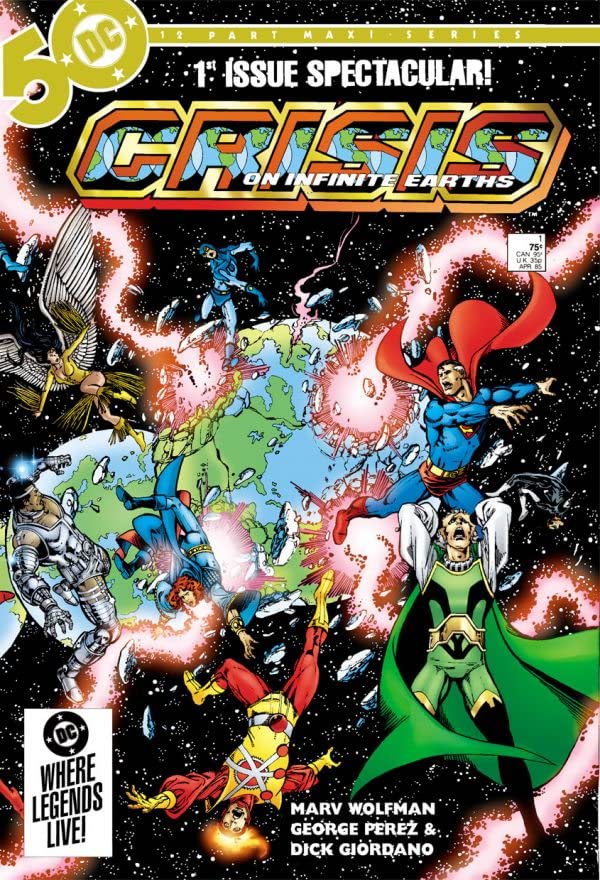
DC had been through an implosion circa 1978 in which dozens of titles were canceled. The company's fortunes started to rise with Crisis on Infinite Earths in 1985 and kept rising.
[editor's note: The following interviews took place in 2017.]
Get the best comic news, insights, opinions, analysis and more!
Paul Levitz, longtime DC executive: "We were coming off a period that was a very, very rich moment. First of all, you had reached the stage where the comic shop side of the business was finally large enough to support its own publishing program and was really perceived as the heart of where the business was going. That meant that you could focus more on things for somewhat older readers, that you could experiment more.
"And with Watchmen and Crisis on Infinite Earths, there was a lot of positive momentum going on in a number of directions at that time. Crisis was a 'New 52 in slow motion,' if you will, where we felt we had the opportunity to relaunch many of the company's titles in some new directions, to try to focus it more clearly on the change in audience that we thought we had.
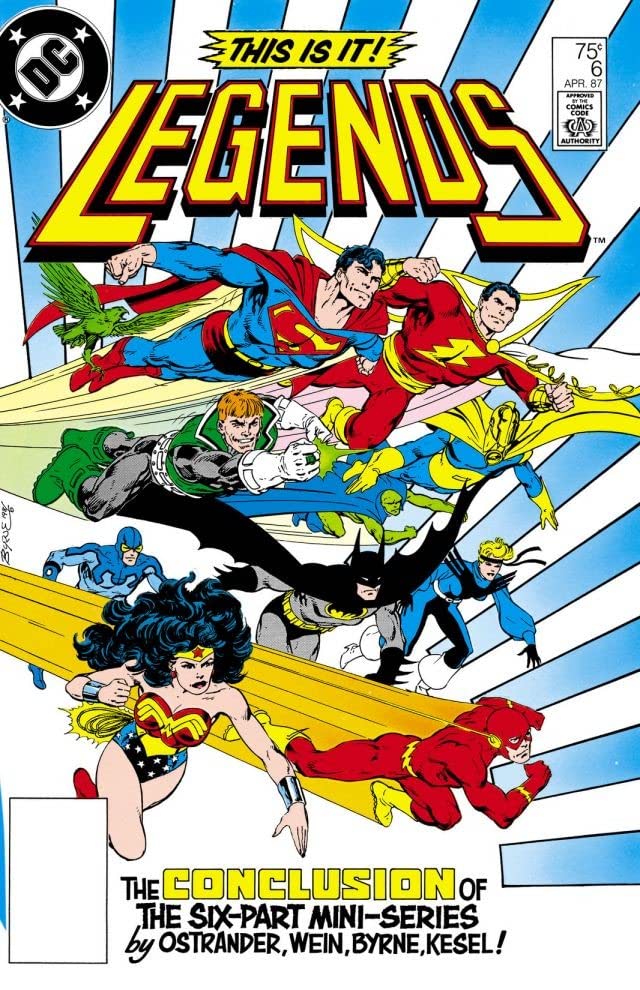
"Man of Steel launched really well, Batman was more of a soft relaunch. Wonder Woman relaunched with George Pérez as the driving force behind that, and what do we do next? Legends was the next up event coming through.
"Justice League had run continuously at that point for, whatever it was, 275 issues, I don't remember what the numbers were. It's okay, it's professional, it's solid, but it's not anything that is particularly focused on the new audience that we're getting. We have a moment of opportunity. Maybe this becomes the next thing that we relaunch? I guess that's what leads us to where you are."
J.M. DeMatteis, co-writer: "My memory is of it being a very busy and creative and exciting time. Our Justice League series came out of the Legends mini-series, and the whole point of Legends was to re-invigorate everything.
"Now when I started at DC in the late '70s…that was a very, very quiet time. It was right after the DC implosion. But by '86, '87, things had started to perk up if not explode. It was a very full-movement, forward-thinking period of time there."
Assembling the team
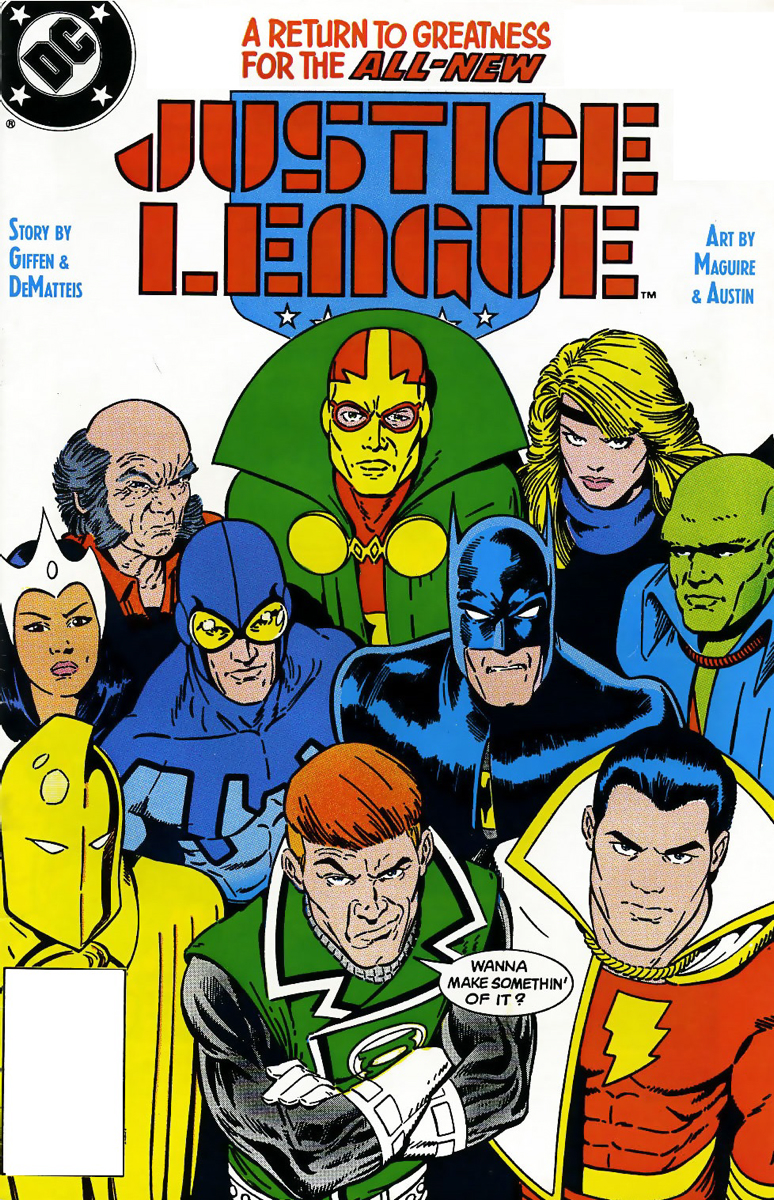
A new League was needed, so Editor Andy Helfer started making calls.
J.M. DeMatteis: "I came on to this project sort of ass-backward. Andy Helfer had brought me in to write the last few issues of the previous incarnation of the Justice League, the Detroit Justice League. He wanted to wrap that up and kill off some characters, so I wrote the final story arc of that Justice League. And I thought I was done."
Keith Giffen, co-writer: "I had been after Andy Helfer for about a year before I finally got the project. 'Let me have Justice League! Let me have Justice League! I can do something with Justice League!'
"So after Legends, I was given Justice League as an assignment. I wish I could say there was more to it than that, but it was really just that I was a freelancer, and I had to eat. Andy Helfer offered me the project, and I snapped it up.
J.M. DeMatteis: "Now Andy and Keith got together and hatched this idea for the new Justice League, which originally, Keith was going to write in total. Now as I recall, Keith kind of chickened out at the last second. He really didn't think he had evolved enough to the point where he could write the book. So Andy got hold of me and said, 'Look, Keith's plotting this, but he really doesn't think he's at the point where he can script it. We'd love to you come in and script.'
"So Andy showed me what Keith had done to that point, which was almost a first-draft script. I said, 'You don't need me! This is already great!' So yeah, my entrée was me saying, 'Please, you don't need me,' but me getting pulled in by the throat anyway. And it turned out, of course, to be one of the best gigs I ever had in my life. But I was not part of the original conception of the book."
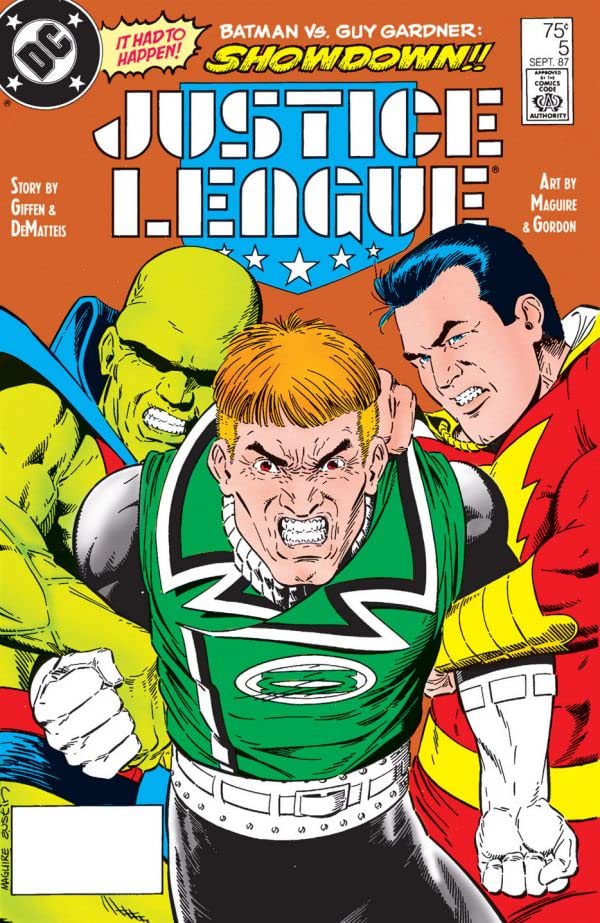
Paul Levitz: "Keith benefits tremendously when he is working with someone who can sit there and go back and forth on the ideas and say, 'That's a great one, Keith. Can we take that another step further?' or 'Okay, maybe we don't do this this way.' At least, that was my experience with him, and certainly one of the joys of our collaboration [Levitz and Giffen had previously co-written Legion of Super-Heroes together] was that half the time, neither of us could remember which piece was which one's idea.
"At the time that he was doing Justice League, which was a few years after most of the work the two of us did together, I don't think he decided that he was a writer yet. Keith came in as an artist, he wanted to draw stories. But he and many others of his generation found themselves being strong contributors to the stories they were working on, in the same way that Jack Kirby or Steve Ditko did back in the early heyday of Marvel.
"But the industry having changed in a bunch of pleasant ways, they were able to make a transition where they woke up one morning and said, 'Oh, I could write this stuff all by myself. I don't just have ideas, I can figure out how to do the rest of the writing job.' Keith was still in the middle of that transition at the time of Justice League."
The co-writing relationship
![1987's Justice League [now "International"] #7](https://cdn.mos.cms.futurecdn.net/wpgVdPvPUUGPUg9WDB3kna.jpg)
Co-writers can work in any of a number of ways. Giffen and DeMatteis had their own method.
Keith Giffen: "First of all, you have to understand, when Andy Helfer was pulling together the Justice League, he put me on the plots. I did not write any of the dialogue. I just plotted it.
"I drew it out like a little mini-comic. I got the beats in, I steered the characters, and then, it was handed over to [J.] Marc [DeMatteis]. At that point in my career, Ambush Bug was pretty popular, so I was kind of known as the Ambush Bug guy. And that book was this wild, absurdist take on superheroes.
"Then Andy goes to bring Marc DeMatteis on board, and Marc was known for doing these very deep, contemplative books like Moonshadow and 'Kraven's Last Hunt.' He was as far from me as you could possibly get. I thought, 'Well that will work. You put a guy that is known for Ambush Bug together with a guy who is known for deep, philosophical stuff [laughs]. Oh, yeah, that will do fine.'"
J.M. DeMatteis: "I used to joke that we worked in glorious isolation. I'd imagine that other people imagined we were in the same room working on this stuff, but it was never that way.
"I would get the plot in the mail, and once in a while, we'd talk on the phone about it. And we'd certainly see each other up at the office on Fridays when we'd go up and get our checks and have lunch with Andy or whatever, but basically…yeah. Keith wrote the plot, I wrote the script, and Andy and Keith gave me the freedom to do with it whatever I felt like. We were always spinning off each other, and off we'd go.
"It's the kind of collaboration that might not work for other people, but for us, it was beautiful. There's no point of ego involved. Keith never said, 'Don't you do that to my plot! That's my plot!' From the second I sat down with it, it became our story, not either individual's."
Adding the artist

Newcomer Kevin Maguire was chosen as the book's artist, and quickly developed a reputation for amazing facial expressions and more.
Keith Giffen: "Andy put the cherry on top by going, 'We'll get Kevin Maguire to draw it.' I think I had heard of Kevin Maguire at the time; he was a new talent. I could be wrong, but I think he was in [Marvel's production department] Romita's Raiders at that point.
"But Andy really liked his stuff, and I am not kidding now, he shows me a picture that Kevin had done to cinch this. It was a shot of Batman, but Batman was Clint Eastwood. Kevin has got this great way with faces, and it was just great. I thought, 'Okay, we'll give this a shot,' but I don't think I've been on a single comic book project where I looked at the creative team and I thought, 'Oh, this is almost tailor-made to fail.' [laughs] I mean, we were all coming from different directions! [laughs] But Andy Helfer had this knack for putting talent together…"
J.M. DeMatteis: "So much of what the book was comes down to Kevin and his attitude, and the attitude he puts into his artwork. Keith and I could have written the exact same book, just as brilliant or horrible depending on your perspective, and if we had a different artist, the book many well have tanked.
"Kevin was unique. I can't think of a single artist that came before Kevin who could do acting on the page the way that Kevin did and still does. His facial expressions, his gestures…we could do an entire page of just close-ups of people's faces, and he could pull that off and make it enthralling. A lot of people have 'done Kevin' since then and been inspired by him, but I think he's still unique. He was very new to the business at the time, but he came in very fully grown. He set the visual template for the book."
Bwah-ha-ha

Justice League clicked quickly and became a breakout hit. Part of the appeal was its sense of humor.
Keith Giffen: "I can say that the original conception was not, 'Hey, we're gonna do a funny superhero book.' That just kind of evolved by itself as we went along."
J.M. DeMatteis: "Maybe we just needed a change, because we were a counterpoint to the grim-and-gritty era, the Dark Knight era. We had a lighter flavor. But who knows?
"I think it's just chemistry—the chemistry between the creative team, and then the chemistry that a creative team accidentally creates with the audience. But what's the 'why' behind that? Can I say Andy was a genius for putting us together? Maybe that's the reason? Why does that happen? I don't know. You can't explain that. At least I can't."
Paul Levitz: "The sense of humor was a part of it. You're at a time when most things were moving darker, and the fact that this was moving lighter might have made it stand out a little bit.
"I think that there's always a window of opportunity for something that is really well done, but sailing opposite to the prevailing wind, because it can stand out. When you're going with the wind, it's harder to be distinctive. If the flavor of the day is dark heroes, a la [Frank] Miller and [Alan] Moore, it's hard to do a dark hero better than those guys, at least at that moment in life.
"Maybe this stands out because it's the lightest hero in the spectrum at the time. The other piece is also, Justice League sold well in an awful lot of incarnations over the years. It sold OK, even at many times when it was done professionally, but not brilliantly. Maybe just the fact that it was a Justice League book being done particularly well was enough to make it a hit."

Keith Giffen: "I will admit that the market was trending kind of dark. But I didn't think of the Justice League as a humor book. All we really do was follow the characters around after they took off their masks, show what they do in their downtime. When I'm in downtime with friends of mine, you goof around, you joke around. It's not a serious time. You don't sit there and brood, so we applied a little bit of that in Justice League. The humor was not intentional. We never intended to do a 'funny' superhero book. It just happened.
"I think the first time we were aware of the fact that what we were doing was the 'Moving Day' issue [#8] where they were moving into the new headquarters. By about the end, it clicked on us that we've got a book with an odd sense of humor."
J.M. DeMatteis: "I think the characters, as we portrayed them, have more of a reality to them than the more quote-unquote 'realistic' takes on superheroes out there. Because the humor humanized the characters. When I look at my own life, remember my friends…humor is such an important part of life. I think the humor was a doorway into these characters. It wasn't just, 'Oh, it's a comedy book.' The comedy was a window into the characters' humanity. It made it feel more real. They felt like your friends, maybe. You want to hang out with [Sienfeld's] George and Kramer and Jerry and Elaine, right? They seem real to you, like your friends. Neurotic friends, but they're your friends. But I think maybe readers wanted to come back every month and just hang out with these characters.
"We had our big action pieces, but the story was never about the action. We realized six, seven issues in that you could just have these characters sit in a room and talk to each other for 22 pages. I kinda joke that we were Seinfeld before Seinfeld. We had had stories about 'nothing.' But they were all based in character. We were never concerned about who we're going to punch this month, it was about 'Hey, what are Beetle and Booster going to do?' 'What's J'onn going to do?'"
Keith Giffen: "When Justice League came out, back then you used to have a couple of months go by before you got the sales figures. We all thought we blew it. We thought we blew it. I thought, 'Okay, that's it. I'm going to be removed from the book.' I started sniffing around DC for whatever work I could pick up after I got blown off Justice League. Marc DeMatteis felt the same way. Kevin felt the same way; he was sniffing around for work.
"We just thought that in this dark, grim-and-gritty world with The Dark Knight Returns and The Longbow Hunters, we thought that our book would nosedive. But after about three months, the sales figures came in nobody was more surprised than us. I mean astonished. It was a hit. Sometimes it works."
(C)over and over again
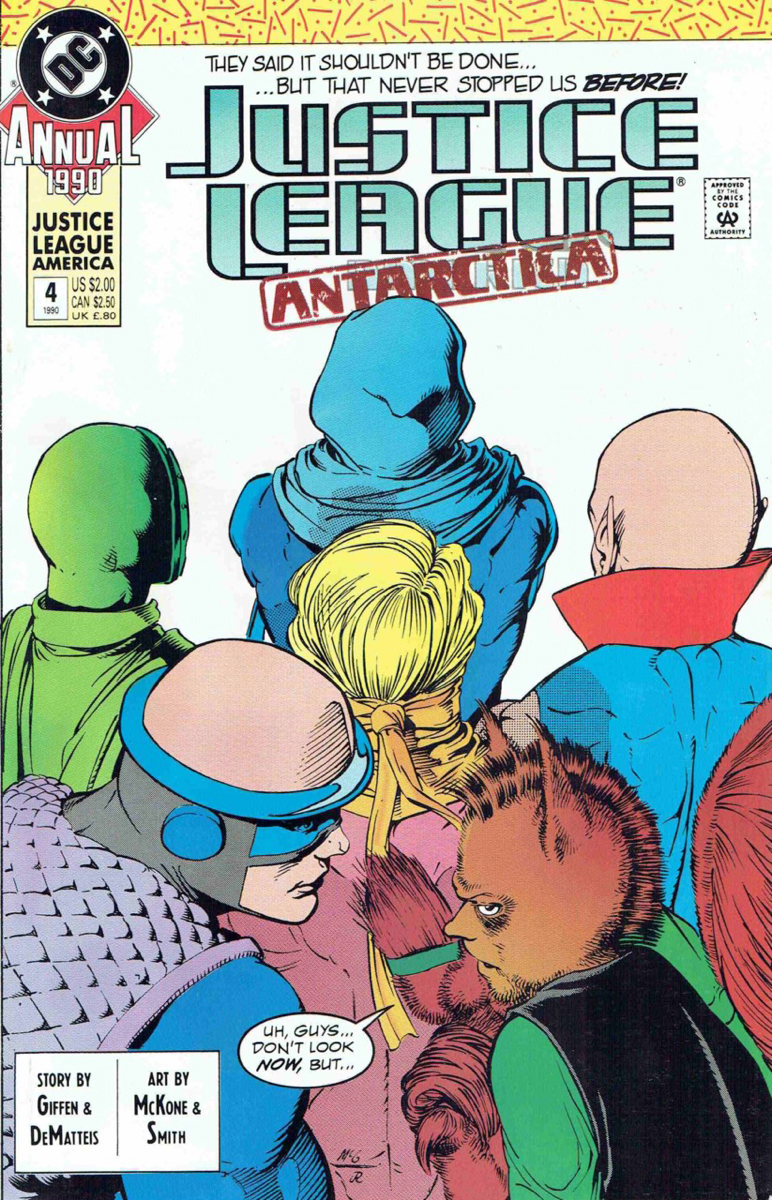
The "Wanna make something of it?" Justice League #1 cover became an important part of the series' branding. It had a certain attitude…that artists have paid homage to over and over. It was parodied on Justice League #24, Justice League Europe #1, and many more.
Keith Giffen: "Kevin certainly nailed it. It has become a classic cover. Again, that was all Kevin. He really landed on something.
"As for of all the homages—let's call them that—I think my favorite is the Justice League Antarctica Annual #1, where they're all facing the wrong way and G'nort's going, 'Hey, guys!' Again, props to Kevin, man. He landed on something good."
J.M. DeMatteis: "I saw another cover just yesterday that homaged that cover. It's been homaged to death.
"Of course [laughs] we started it. Whenever there was a new lineup or whatever we might do it. We did it with villains, and there was a classic Justice League Antarctica where it was the same pose, but they were all facing the wrong way. The Antarctica one might be my favorite out of the bunch. But again, that speaks to Kevin's gifts that he could say so much with such a simple shot. It tells you everything you need to know."
And now, a word about Keith Giffen

Talk to enough creators, and you can't help but find an eternal thread, which is the kindness and generosity of Keith Giffen.
J.M. DeMatteis: "Keith is really, really selfless. He's a great collaborator. One of the reasons our collaboration works so well and that we continue to collaborate 30 years later is that there's no ego involved. He does the plot, and I have the freedom to go off in 30 different directions.
"Sometimes I'll hew very closely to what he's done, but sometimes I'll write bring in new character bits, new plot bits. Someone else might freak out and go 'What are you doing to my plot?' but Keith always likes and encourages that. I'll build on what he did, he'll build on what I did, whatever. That's the fun of our collaboration. It's never, 'That's your turf and this is mine.' It's always the two of us playing creative tennis."
Paul Levitz: "I think Keith is certainly generous. And I think he genuinely enjoys playing with others. He probably has the most fertile imagination of anybody in my generation in comics. We're not dissimilar in age, I came in the business a little bit before him.
"He'll come up with 100 ideas. 30 of them are absolutely stupid and useless, 30 of them are absolutely wonderful, and 30 of them are OK, but they really need a whack on the side of the head to be fit into whatever the thing is. But he keeps generating ideas. There's no end to his imagination."
Keith Giffen: "I have no idea how to respond to that. And I can't reach around to pat my own back like that.
"And you have to understand that with Justice League, everyone gets the idea that we were all so closely knit. Today, Marc and I hang out together and talk on the phone constantly, but with Justice League, we barely communicated. It was an assignment, and we were pushing a deadline.
"And when it comes to the writing of the book, all props to Marc. I plotted the book. I broke it down, I plotted it, I handed it off and Marc just went to town on it. Then I'd read the script and maybe one or two things would jump out of me and I revisited the next issue. A lot of these things became recurring themes.
"As an example, Marc and I constantly bicker back and forth about who came up with 'Bwa-ha-ha!' He swears that he saw it the first time in one of my plots. I swear I read it the first time in the book. Now, it would be very easy for us to check because I believe Andy Helfer has all of the Justice League plots.
"But it's not that important to us. We were working together as a team on the book."
The ramp up, the wind down...

Justice League spawned a Justice League Europe title, a Justice League Quarterly, and more. The workload was big, and Giffen and DeMatteis kept up for a long while.
J.M. DeMatteis: "I went on for five years. I did the first eight issues or so of Justice League Europe, and there was Justice League Quarterly where I usually did the lead story there and sometimes backup stories, too. By the last year, I think Keith and I just felt, 'You know what? It's been a great run, but I think we're getting a little tired.'
"The last thing you want to do, especially when you're on a book that's been very successful and that you're very proud of, is keep doing it when you're losing steam. DC didn't tell us we were done. We decided when we were done. And we went on our way."
Keith Giffen: "Actually, I exited much later than I wanted to. Marc and I wanted to leave with #50. Andy Helfer, because he's got this way about him, sort of convinced us to stay on. I think in a way we overstayed our welcome. I think some of the stories after #50…not quite up to par."
"There were some good stories, don't get me wrong. We did nail it a couple of times, but I think after #50 we were more or less just doing time, waiting for the cell doors to open. My main reason for leaving a book has always been that moment when I realize there are still dozens and dozens, maybe hundreds of stories that I can tell with these characters…but there's none I want to. That was pretty much where I was at that point. I believe Marc felt the same way. Yeah, we stayed on. I think we stayed on until 60-something. If I could go back and relive that moment I probably wouldn't have stayed on."
J.M. DeMatteis: "I have to step aside and say Andy Helfer is one of the best editors to ever work a book, anywhere, anytime, at any company in the business. He's a phenomenally gifted guy."
Keith Giffen: "I would be remiss if I didn't mention we also worked with other artists. We worked with Ty Templeton, Adam Hughes, Mike McKone, my man Mike McKone, and they all did spectacular work. We were blessed on this book, let's face it. The talent that we were working with was top-notch talent across the board."

The legacy
It's been over 35 years. The Giffen-DeMatteis-Maguire Justice League—let's face facts, that's what most people call it—has achieved iconic status and is still constantly reprinted, with new fans finding it every day.
J.M. DeMatteis: "The fun this with this Justice League thing is just that it's lived…this…long! It keeps getting reprinted. There's a big omnibus coming out. And new people keep discovering it for the first time. I go to shows today and meet people who are just reading it for the first time, 30 years later. It's a great thing that it's had this long life. And we don't take that for granted. We really appreciate it.
Paul Levitz: "The lasting legacy is that you've got a concept like Justice League, which between the Justice Society stories and the Justice League stories, has been a part of the DC mythos for almost 80 years now. And if you were to isolate what the most interesting, creative periods were ... the most successful creative periods, this would be on that very short list. And to be one of the peak moments in an 80-year history is a pretty good answer in and of itself, I think."
Keith Giffen: "We were sailing into a headwind basically. We had no idea what would happen with this book. We had a book with an odd outlook. We got lucky. Why did the fans embrace it? I don't know. Thank God, they did. I'll be forever grateful to them. To ask me how or why the book succeeded…I don't know, I'm not the guy to ask."
Paul Levitz: "The other piece of the legacy is that I think it enriched several of the characters that moved through it, who had either preexisted in the DC Universe in a very trivial way like Fire and Ice, or that had recently moved into the DC universe like Blue Beetle, gave them real definition, and made them meaningful parts of the DC Universe.
"That's a rare event. You think back on the long run of something like Avengers, or Justice League, and there's only a handful of times when it serves as an opportunity to reinvent somebody. I remember Hercules getting that benefit in Avengers when I was a kid in [writer] Roy Thomas' material. He became a much more interesting character than he had been in the Thor comics. But it doesn't happen often. This run did that for a bunch of characters."
J.M. DeMatteis: "These days, I talk to Keith probably more than anyone else I know in the business. Maybe two or three times a week."

Paul Levitz: "We had a lot of fun, and I think it showed in the book. That is often the case with great comics, but I think that's part of what the readers were responding to. It wasn't just the fact that it was funny, but you had the sense that the people who were working on it were really enjoying the hell out of themselves. I think that playfulness is part of the magic."
Keith Giffen: "You're right, I find it hard to believe I'm on the phone talking to you about this still. 30 years. If you would have told me 30 years ago, 'When you're 64, you'll be on the phone talking about One…Punch!, I'd have written you off as crazy.
"We had fun. We enjoyed doing it. What I remember the most from Marc and Kevin and I working on Justice League is that it was fun to do. All comics are a machine, penciler to inker to colorist, bum-bum-bum-bum-bum. But this was really an enjoyable gig. I can't think of anything about our run on Justice League, at least from #1 to #50, that I regret doing, or that I have second-guessed myself over. I guess that's it. Let that be the coda: 'They had fun.'"
The Giffen-DeMatteis-Maguire Justice League is of course one of the best Justice League line-ups of all time.
—Similar articles of this ilk are archived on a crummy-looking blog. You can also follow @McLauchlin on Twitter


